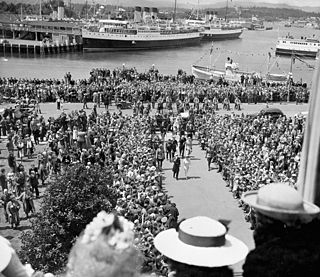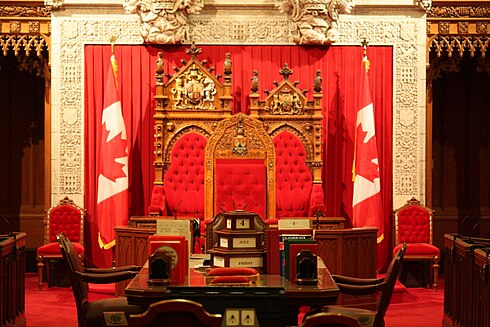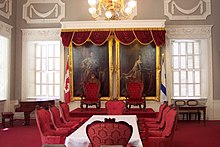
The governor general of Canada is the federal representative of the Canadian monarch, currently King Charles III. The King or Queen is monarch and head of state of Canada and 14 other Commonwealth realms, and resides in the oldest and most populous realm, the United Kingdom. The monarch, on the advice of his or her Canadian prime minister, appoints a governor general to administer the government of Canada in the name of the monarch, performing most of the king or queen's constitutional and ceremonial duties. The commission is for an indefinite period—known as serving at His Majesty's pleasure —though five years is the usual length of time. Since 1959, it has also been traditional to alternate between francophone and anglophone officeholders; although, many recent governors general have been bilingual.

The monarchy of Canada is Canada's form of government embodied by the Canadian sovereign and head of state. It is one of the key components of Canadian sovereignty and sits at the core of Canada's constitutional federal structure and Westminster-style parliamentary democracy. The monarchy is the foundation of the executive (King-in-Council), legislative (King-in-Parliament), and judicial (King-on-the-Bench) branches of both federal and provincial jurisdictions. The current monarch is King Charles III, who has reigned since 8 September 2022.

The Parliament of Canada is the federal legislature of Canada, seated at Parliament Hill in Ottawa, and is composed of three parts: the King, the Senate, and the House of Commons. By constitutional convention, the House of Commons is dominant, with the Senate rarely opposing its will. The Senate reviews legislation from a less partisan standpoint and may initiate certain bills. The monarch or his representative, normally the governor general, provides royal assent to make bills into law.
The Canadian order of precedence is a nominal and symbolic hierarchy of important positions within the governing institutions of Canada. It has no legal standing, but is used to dictate ceremonial protocol.

A speech from the throne, or throne speech, is an event in certain monarchies in which the reigning sovereign, or their representative, reads a prepared speech to members of the nation's legislature when a session is opened. The address sets forth the government's priorities for its legislative agenda, for which the cooperation of the legislature is sought. The speech is often accompanied by formal ceremony. It is often held annually, although in some places it may occur more or less frequently, whenever a new session of the legislature is opened.
The Great Seal of Canada is a governmental seal used for purposes of state in Canada, being set on letters patent, proclamations and commissions, both to representatives of the monarch and for the appointment of cabinet ministers, senators, and judges. Many other officials, such as officers in the Canadian Armed Forces, receive commissions affixed with the Privy Seal, not the great seal. It is not for sealing up a document as letters close. As a de facto symbol of Canada the seal is one of the oldest and most honoured instruments of the Canadian government.

The Canadian Oath of Allegiance is a promise or declaration of fealty to the Canadian monarch—as personification of the Canadian state and its authority, rather than as an individual person—taken, along with other specific oaths of office, by new occupants of various federal and provincial government offices; members of federal, provincial, and municipal police forces; members of the Canadian Armed Forces; and, in some provinces, all lawyers upon admission to the bar. The Oath of Allegiance also makes up the first portion of the Oath of Citizenship, the taking of which is a requirement of obtaining Canadian nationality.

The lieutenant governor of Nova Scotia is the representative in Nova Scotia of the Canadian monarch, King Charles III, who operates distinctly within the province but is also shared equally with the ten other jurisdictions of Canada, as well as the other Commonwealth realms and any subdivisions thereof, and resides predominantly in his oldest realm, the United Kingdom. The lieutenant governor of Nova Scotia is appointed in the same manner as the other provincial viceroys in Canada and is similarly tasked with carrying out most of the monarch's constitutional and ceremonial duties. The present, and 33rd lieutenant governor of Nova Scotia is Arthur Joseph LeBlanc, who has served in the role since 28 June 2017.

The Centre Block is the main building of the Canadian parliamentary complex on Parliament Hill, in Ottawa, Ontario, containing the House of Commons and Senate chambers, as well as the offices of a number of members of parliament, senators, and senior administration for both legislative houses. It is also the location of several ceremonial spaces, such as the Hall of Honour, the Memorial Chamber, and Confederation Hall.

Government House of Nova Scotia is the official residence of the lieutenant governor of Nova Scotia, as well as that in Halifax of the Canadian monarch. It stands in the provincial capital at 1451 Barrington Street; unlike other provincial Government Houses in Canada, this gives Nova Scotia's royal residence a prominent urban setting, though it is still surrounded by gardens.

In Canada, a lieutenant governor is the representative of the King of Canada in the government of each province. The Governor General of Canada appoints the lieutenant governors on the advice of the Prime Minister of Canada to carry out most of the monarch's constitutional and ceremonial duties for an unfixed period of time—known as serving "Her Excellency’s pleasure"—though five years is the normal convention. Similar positions in Canada's three territories are termed "Commissioners" and are representatives of the federal government, not the monarch directly.

Canadian royal symbols are the visual and auditory identifiers of the Canadian monarchy, including the viceroys, in the country's federal and provincial jurisdictions. These may specifically distinguish organizations that derive their authority from the Crown, establishments with royal associations, or merely be ways of expressing loyal or patriotic sentiment.

The history of monarchy in Canada stretches from pre-colonial times through to the present day. The date monarchy was established in Canada varies; some sources say it was when the French colony of New France was founded in the name of King Francis I in 1534, while others state it was in 1497, when John Cabot made landfall in what is thought to be modern day Newfoundland or Nova Scotia, making a claim in the name of King Henry VII. Europeans in the 16th and 17th centuries often considered the territories belonging to different aboriginal groups to be kingdoms. Nevertheless, the present Canadian monarchy can trace itself back to the Anglo-Saxon period and ultimately to the kings of the Angles and the early Scottish kings; monarchs reigning over Canada have included those of France, those of the United Kingdom, and those of Canada. Canadian historian Father Jacques Monet said of Canada's Crown, "[it is] one of an approximate half-dozen that have survived through uninterrupted inheritance from beginnings that are older than our Canadian institution itself."

By the arrangements of the Canadian federation, Canada's monarchy operates in Quebec as the core of the province's Westminster-style parliamentary democracy and constitution. As such, the Crown within Quebec's jurisdiction is referred to as the Crown in Right of Quebec, His Majesty in Right of Quebec, or the King in Right of Quebec. The Constitution Act, 1867, however, leaves many royal duties in the province specifically assigned to the sovereign's viceroy, the lieutenant governor of Quebec, whose direct participation in governance is limited by the conventional stipulations of constitutional monarchy.

By the arrangements of the Canadian federation, the Canadian monarchy operates in Prince Edward Island as the core of the province's Westminster-style parliamentary democracy. As such, the Crown within Prince Edward Island's jurisdiction is referred to as the Crown in Right of Prince Edward Island, His Majesty in Right of Prince Edward Island, or the King in Right of Prince Edward Island. The Constitution Act, 1867, however, leaves many royal duties in Prince Edward Island specifically assigned to the sovereign's viceroy, the lieutenant governor of Prince Edward Island, whose direct participation in governance is limited by the conventional stipulations of constitutional monarchy.

The monarchy of Canada forms the core of each Canadian provincial jurisdiction's Westminster-style parliamentary democracy, being the foundation of the executive, legislative, and judicial branches of government in each province. The monarchy has been headed since September 8, 2022 by King Charles III who as sovereign is shared equally with both the Commonwealth realms and the Canadian federal entity. He, his consort, and other members of the Canadian royal family undertake various public and private functions across the country. He is the only member of the royal family with any constitutional role.
The politics of Nova Scotia take place within the framework of a Westminster-style parliamentary constitutional monarchy. As Canada's head of state and monarch, Charles III is the sovereign of the province in his capacity as King in Right of Nova Scotia; his duties in Nova Scotia are carried out by the Lieutenant Governor, Arthur LeBlanc. The General Assembly is the legislature, consisting of the Lieutenant Governor and fifty-five members representing their electoral districts in the House of Assembly. The Government is headed by the Premier, Tim Houston, who took office on August 31, 2021. The capital city is Halifax, home to the Lieutenant Governor, the House of Assembly, and the Government. The House of Assembly has met in Halifax at Province House since 1819.

Royal tours of Canada by the Canadian royal family have been taking place since 1786—when the future King William IV became the first member of the royal family to visit Canada—and continue into the 21st century, either as an official tour, a working tour, a vacation, or a period of military service by a member of the royal family. In 1939, King George VI became the first reigning monarch to tour the country.

The opening of the Canadian parliament is the commencement of a session of the Parliament of Canada following a general election. It involves summons from the governor general on behalf of the monarch and a ceremony based on the same in the United Kingdom, though less elaborate and now evolved to include uniquely Canadian elements.



















